Here at DC Histories, we try to make sense of the continuity that perplexes, befuddles, and intimidates. We discuss what worked and what didn’t. This week, we’re talking about Action Comics Weekly, DC’s very first weekly comic series.
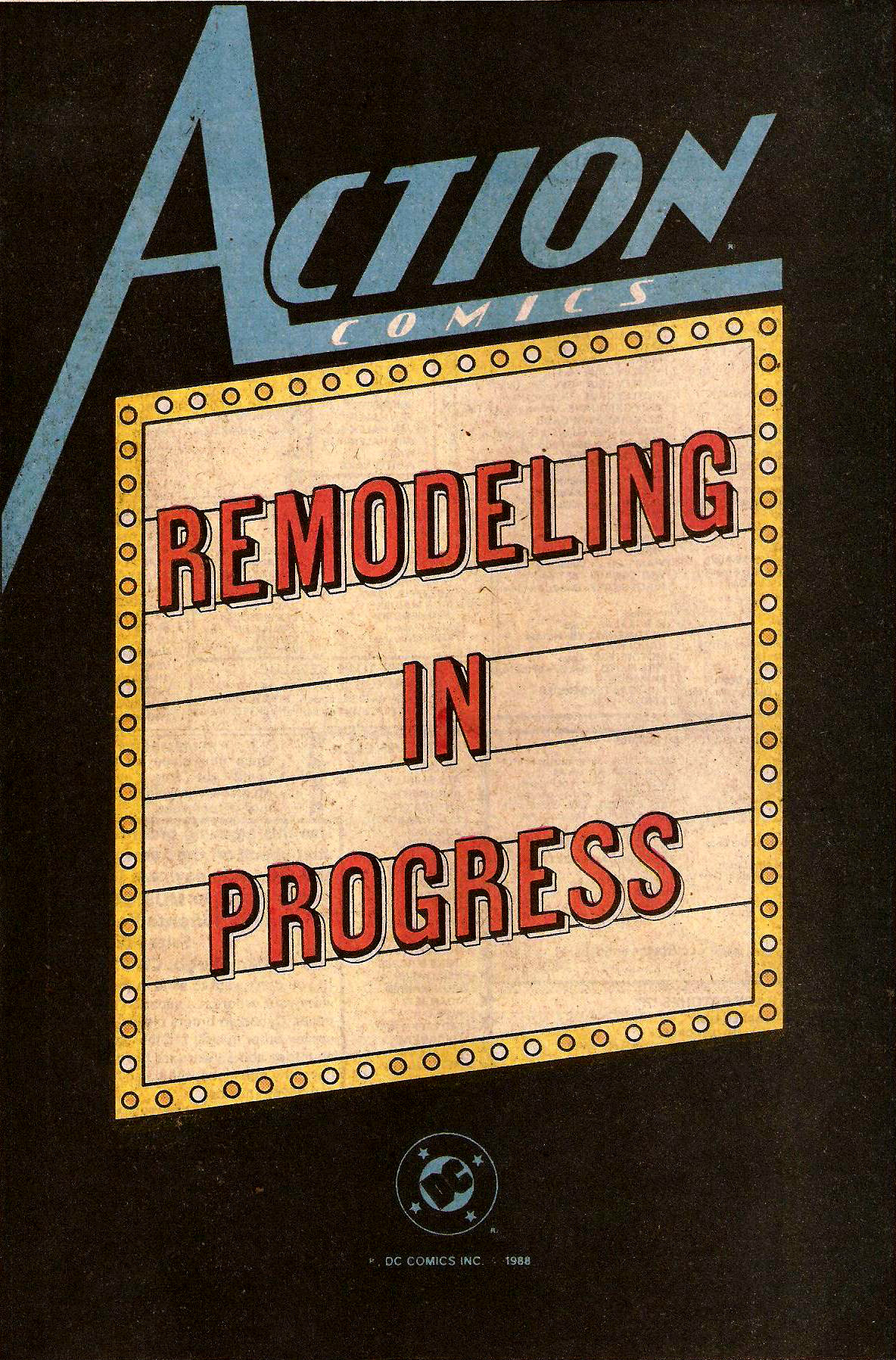
Action Comics Weekly (1988) In-House Ad
In 1988, the anthology series was dead at DC Comics. Formerly a mainstay of the comics industry, the anthology died as comics become more focused on specific characters who had their names in titles. Backup features slowly died and every issue was only about the character whose name was on the cover.
Meanwhile, Action Comics was in a period of transition. After Superman’s post-Crisis revamp, the series had become a team-up title between the new Superman and other members of the DCU. It culminated in issue 600, which featured Superman attempting to date Wonder Woman. John Byrne, the architect of this Action Comics run, was making moves to leave the Superman universe and a big number like 600 was viewed as a nice exit for him. Instead of simply rotating in another creator and keeping everything business as usual, a major change was tried. It was decided that Action Comics would move back to its original 1938 roots. No longer would Superman be the star of the book. Now, he’d be one of many. Five short eight-page stories featuring different members of the DCU would crammed between two covers with Superman only getting two pages an issue for his tale. The whole thing would come out every seven days and be titled Action Comics Weekly.
It was a bold move and a stunning change to a book whose format had remained relatively steady since Superman became Action Comics‘ break out star. But, in May 1988, the first issue of Action Comics Weekly hit stands. Featuring stories about Deadman, the vigilante Wild Dog, the Blackhawks, Green Lantern, a group named the Secret Six, and Superman, the diverse lineup grabbed readers’ attention.
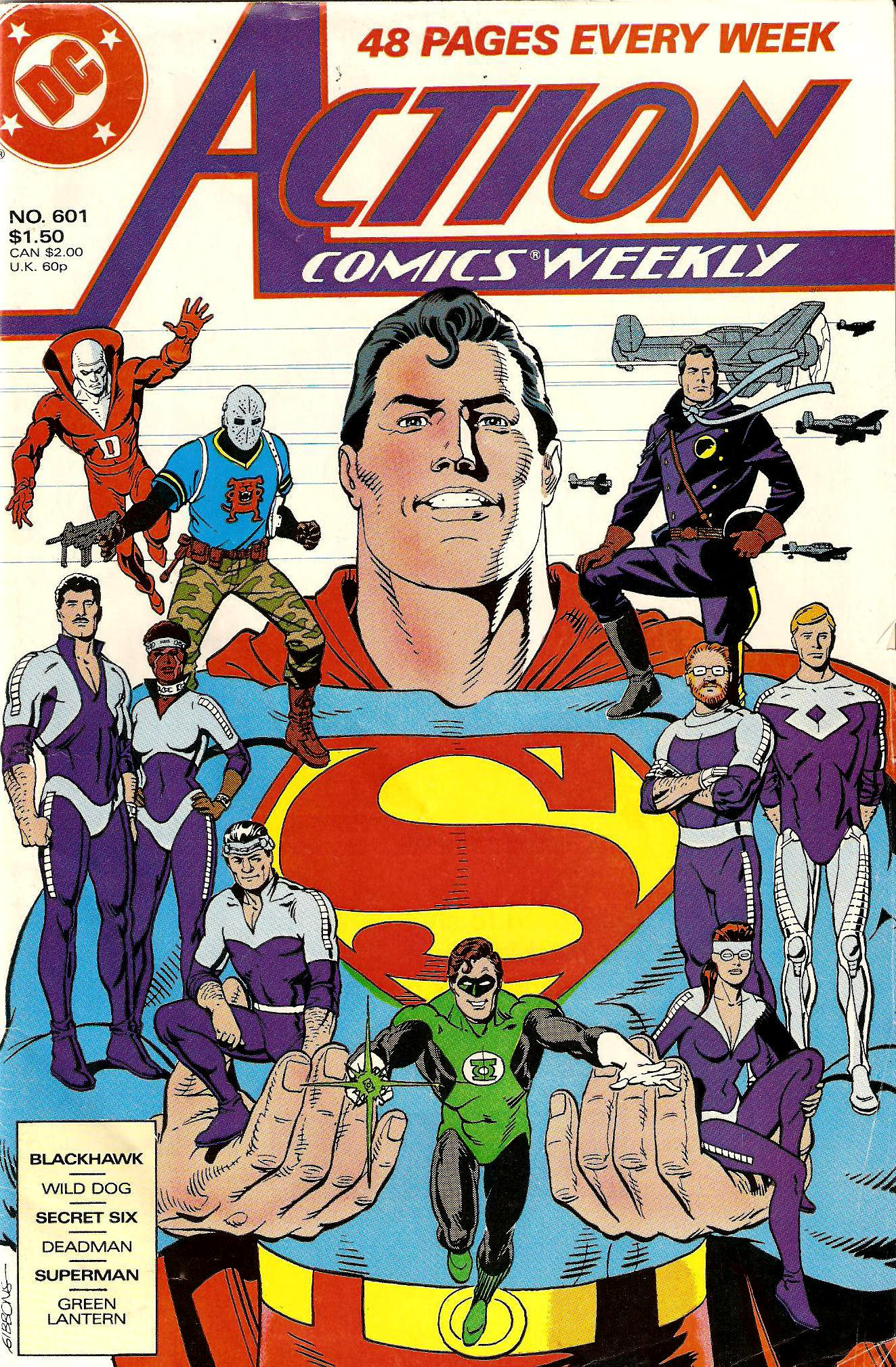
Action Comics Weekly #601 (1988) Cover
From there on, every week found a new issue on comic store shelves. If readers didn’t enjoy a particular story, there was another one in just a few pages which featured a completely different art style, tone, and genre. From the surreal adventures of Deadman to the super heroics of Hal Jordan to the war adventures of the Blackhawks, the shift from story to story kept things moving right along.
Many of the characters in these stories may not be known to current readers. Among this group was a character named Wild Dog, a creation of writer Max Allen Collins and artist Terry Beatty. He’d debuted in a solo miniseries the previous year and DC felt strongly enough about him to allow more adventures to be told in this new format. With his Friday the 13th-esque hockey mask, he was a bit of a derivative shoot-first-and-ask-questions-later vigilante. Still, Collins and Beatty were seasoned enough pros to keep his story from becoming too terribly stale as he fought against murderous censorship organizations and serial killers. Picture the Punisher with a hockey mask and you’ve not far off.
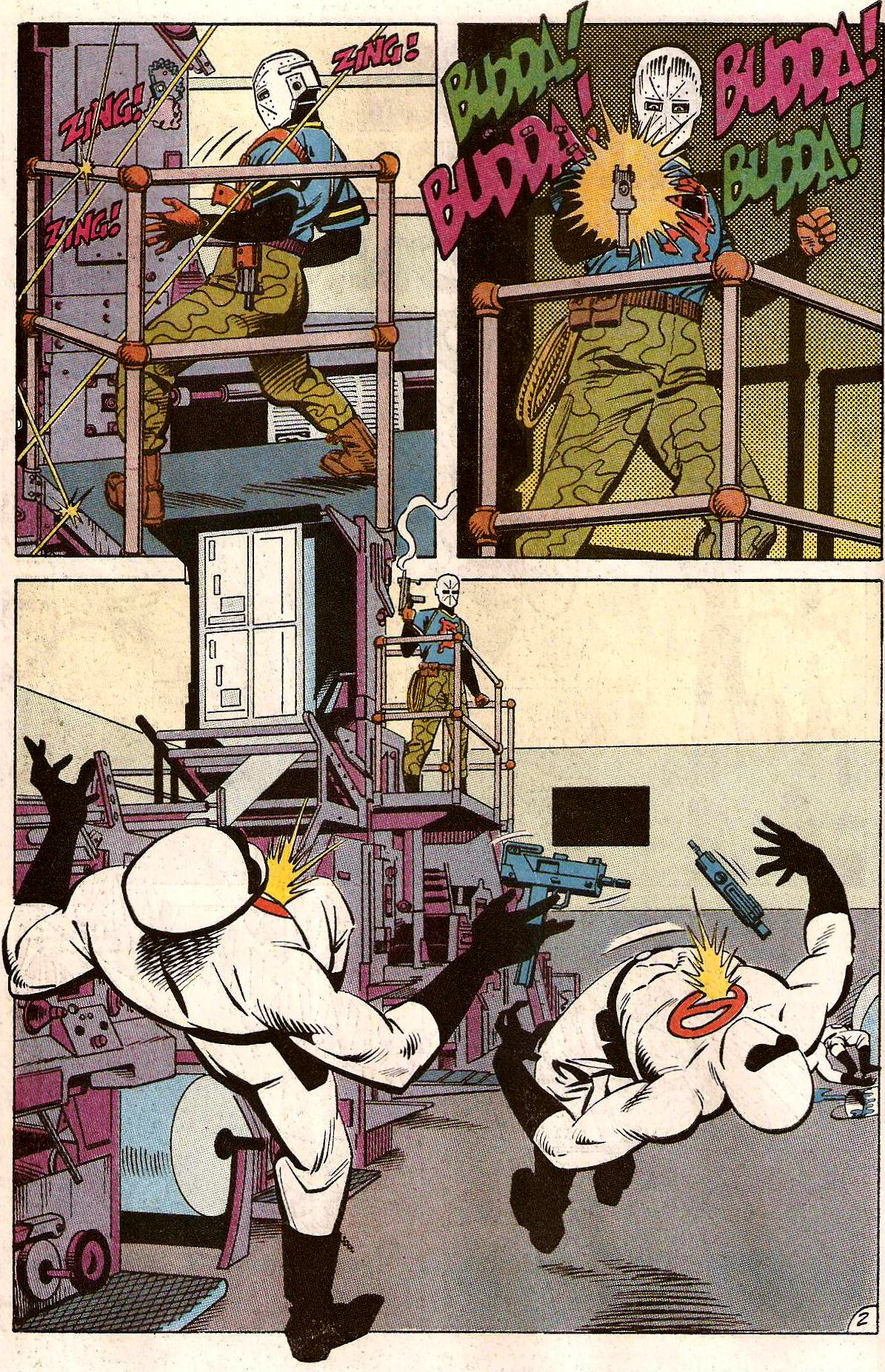
From Action Comics Weekly #607 (1988)
The Secret Six were a group that first formed in 1968. During seven bi-monthly issues, the original Secret Six had starred in their own titular comic series. There, a group of individuals found themselves blackmailed into doing the bidding of a cloaked figure known only as Mockingbird. Usually, the group did good in the world, but did so without free will. When their series was cancelled in 1969, they disbanded. In the pages of Action Comics Weekly, a new Secret Six was formed by Mockingbird when the original Six were killed. This time, each member of the Six was granted some sort of mechanical means to overcome a physical limitation. However, if they rebelled against Mockingbird, that mechanism was disabled. At the end of their time in Action Comics Weekly, the group discovered the identity of Mockingbird and managed to bring several more criminals to justice. After this story ended, none of them were seen again.
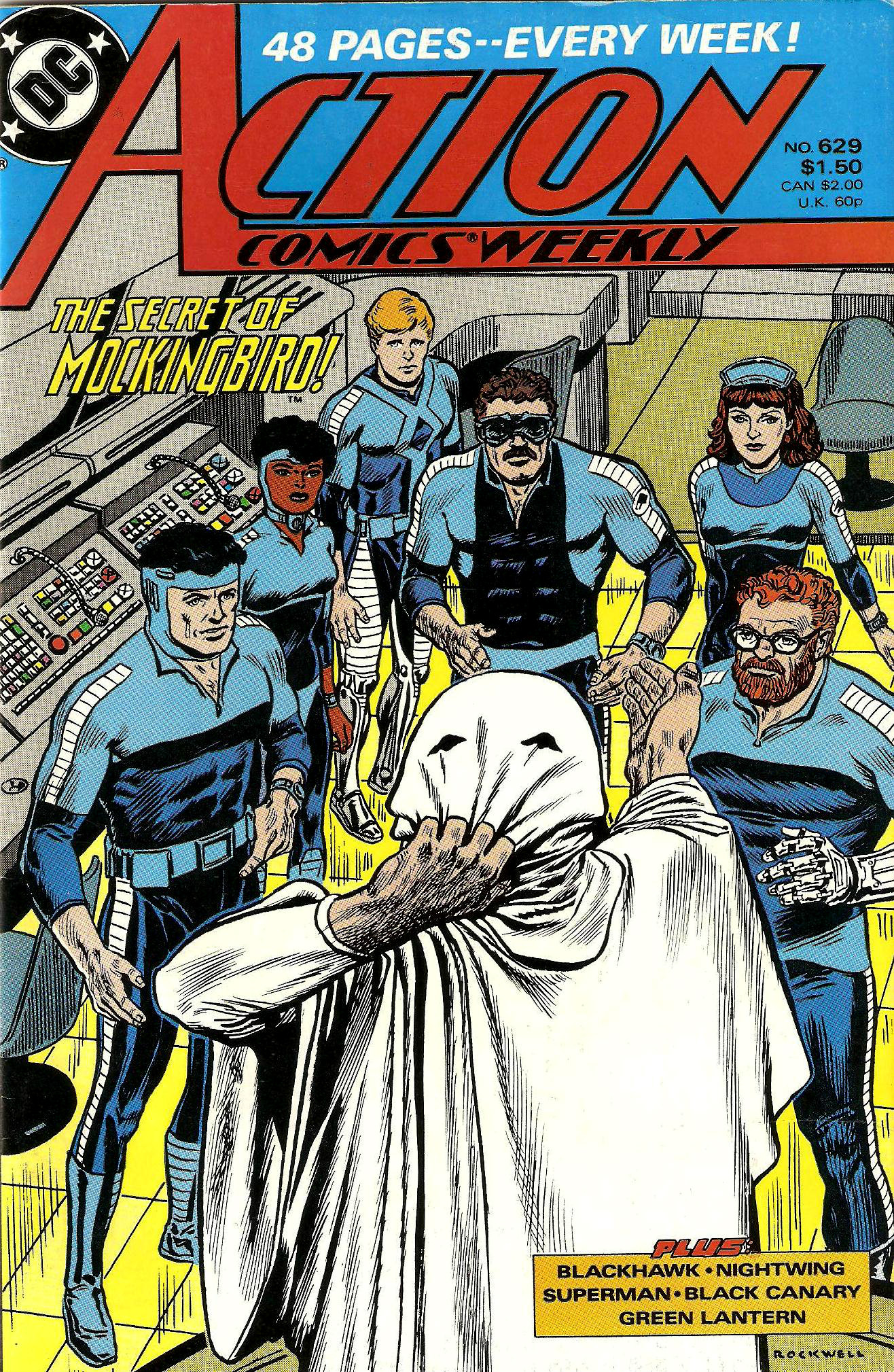
Action Comics Weekly #629 (1988) Cover
Elements of this story were later referenced in the early Villains United miniseries written by Gail Simone in her revamp of the Secret Six prior to Infinite Crisis.
Unfortunately, the Secret Six’s stories were incredibly slow and the art in their first story arc was muddy. I lost the thread of it fairly early on and never recovered. Judging from the letters pages of these issues, some readers agreed with me while others absolutely loved the story.
Speaking of stories that moved so slowly they became neigh-unreadable, there was the Superman two-page story found in every issue. Written by Roger Stern and drawn by Superman legend Curt Swan, these pages were meant to be a loving tribute to old fashioned Sunday adventure newspaper comics. Perhaps these stories would have played better than they did if they weren’t one complete story. Sadly, that wasn’t the case as a 38 chapter tale told in two page chunks was published over the better part of a year. Featuring a story in which Superman dealt with a group of Californians who thought he was a god, the tale ended on a high note when Darkseid showed up, but by then it was too little too late. The build-up, with its leisurely pace and weird blind alleys it went down, killed the story’s momentum.

From Action Comics Weekly #615 (1988)
Easily the best thing in the entire run of Action Comics Weekly were the Blackhawk tales. The first multi-part story was written by Mike Grell but the two later Blackhawk tales were written by Martin Pasko. Each eight page chapter was beautifully drawn by Rick Burchett, whose work has always been top notch. It’s worth tracking down these issues if only for Burchett’s work.
Unfortunately, the tone of the Blackhawk pieces never fit in with the other tales in each issue. Had these stories been published by themselves, they’d probably have been labeled “For Mature Readers” on the cover. Sex, violence, and barely contained nudity were happening constantly, like when Jan was drugged full of LSD and hallucinated that Lady Blackhawk was making time with one of his friends. This story, though excellent, didn’t vibe very well with, say, a Curt Swan drawn Superman story.
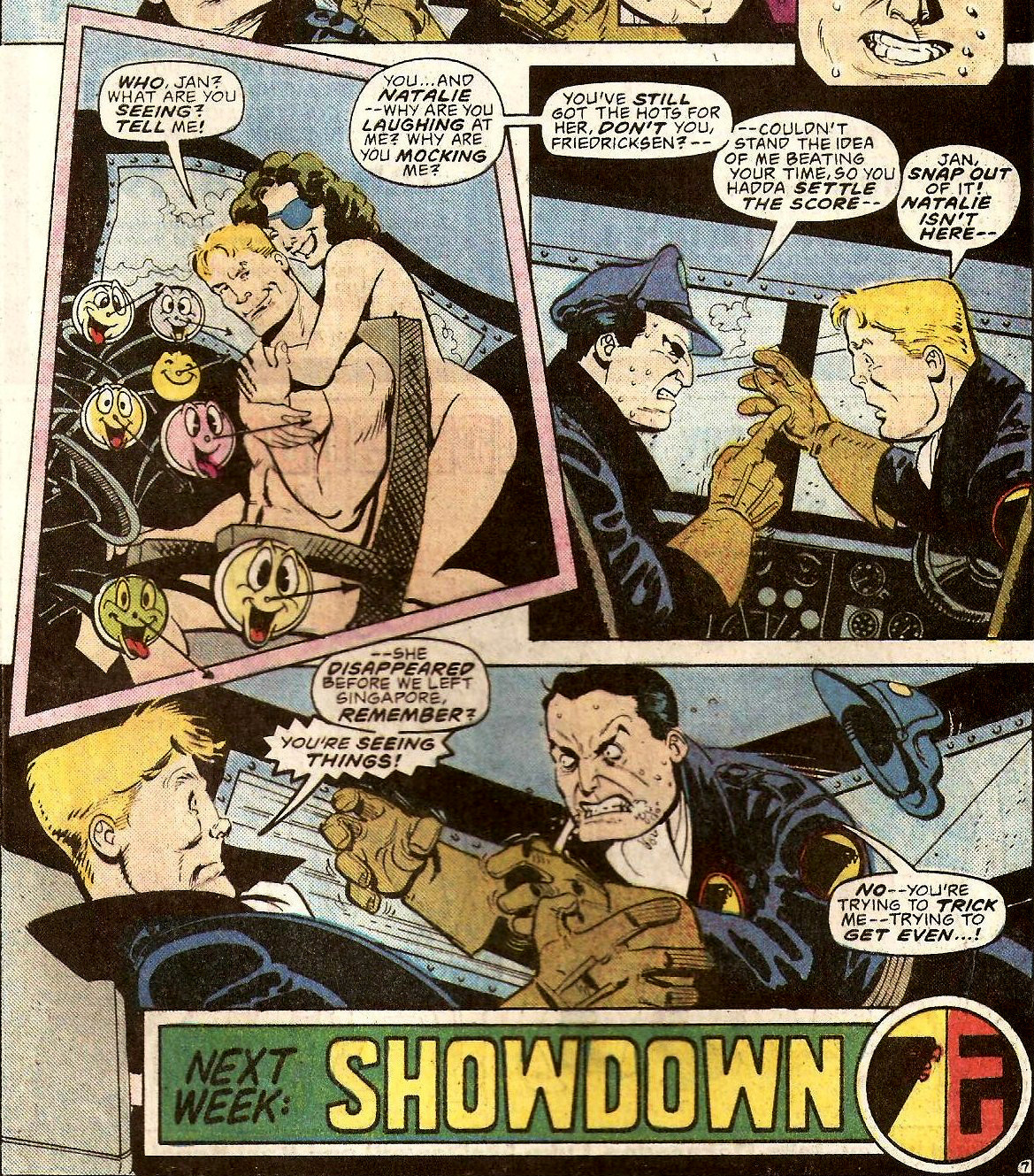
From Action Comics Weekly #633 (1989)
At several points during this series’ run, characters were given stories to see if they could support a solo tale. After getting rebooted a year earlier, Captain Marvel was given a four chapter trial run. Nightwing and Speedy were given a few stories away from the various Titans. And Catwoman got a four chapter solo story to see if she could support her own miniseries. During that particular tale, Holly Robinson, Selina’s friend who had debuted during Batman: Year One, was killed. Most people missed this fact and Holly appeared alive and well in Ed Brubaker’s 2002 Catwoman reboot. But really, that was for the best.
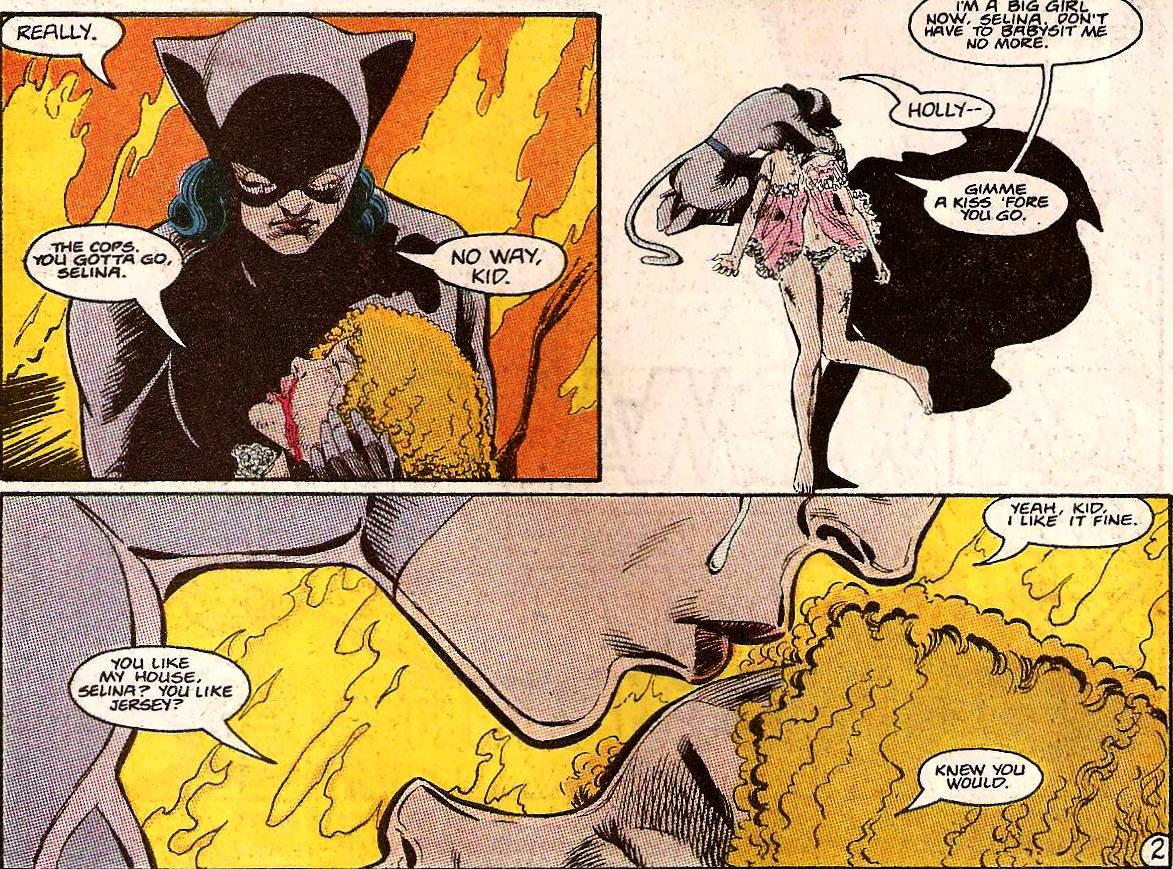
From Action Comics Weekly #613 (1988)
Action Comics Weekly was also the first place where Kelley Jones drew his take on Deadman. His skeletal, almost zombie-like work on the character would go on to become a defining one for many readers in later miniseries and Deadman guest appearances that Jones drew. It seems that the weekly demands were a bit tough on Jones as this Deadman story was one that skipped one week and had a fill-in penciller for another chapter. Still, what Jones did put out was quality stuff and made it clear that he had more he wanted to do with the character.
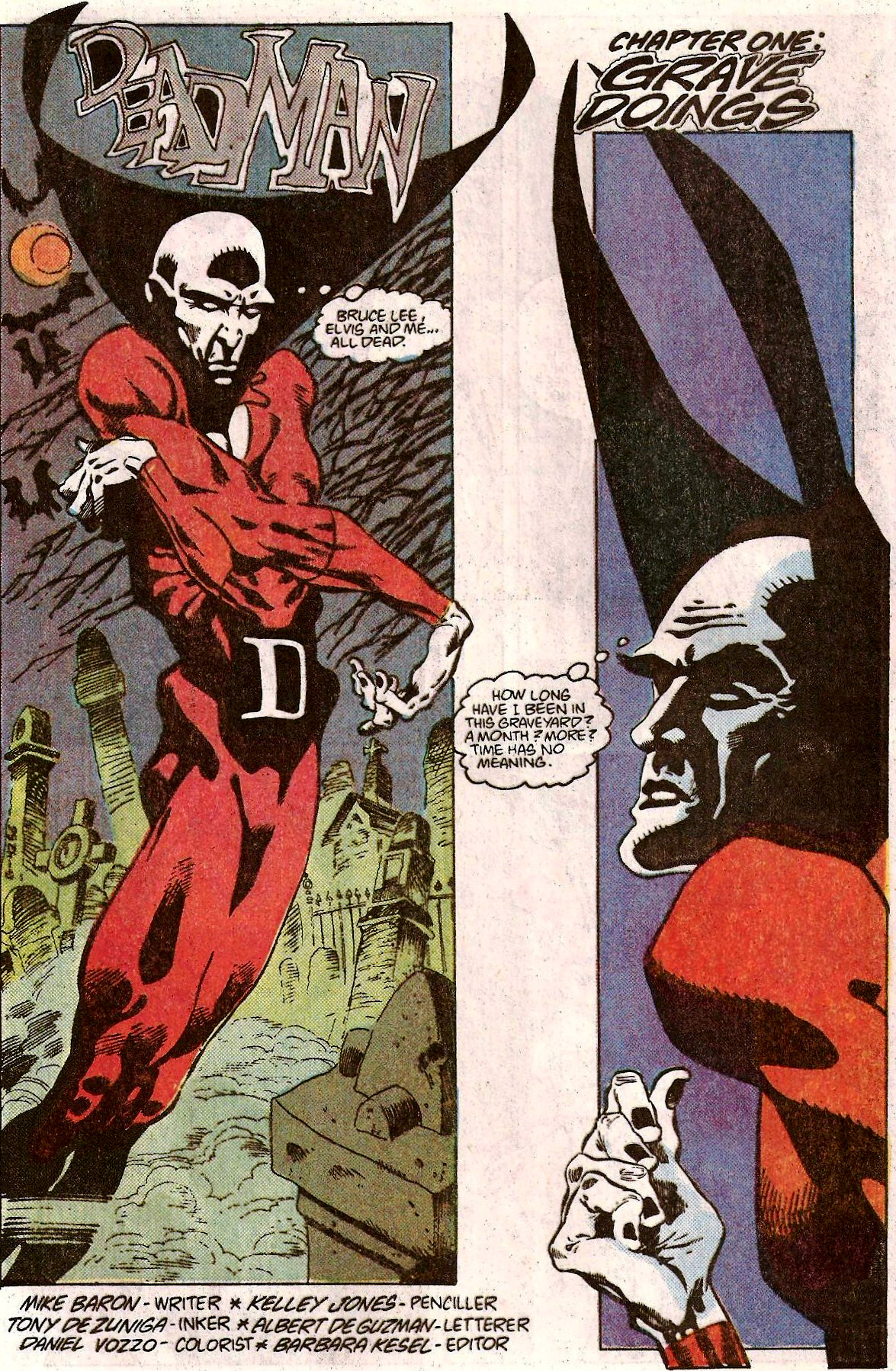
From Action Comics Weekly #618 (1988)
Though I’m highlighting a few stories found in these issues, there were plenty of others. Black Canary had a few solo tales away from Green Arrow, though the quality of these stories wasn’t where it should have been. Phantom Lady was given a reboot near the end of ACW‘s life, but its art makes me unable to recommend that particular tale. The Phantom Stranger appeared here and there, but my irrational dislike of that character colored my views on his stories. Etrigan was given a few issues to try out a story, which turned out quite well. This would be Alan Grant’s first time writing the character and he moved over to writing Etrigan’s ongoing series the following year.
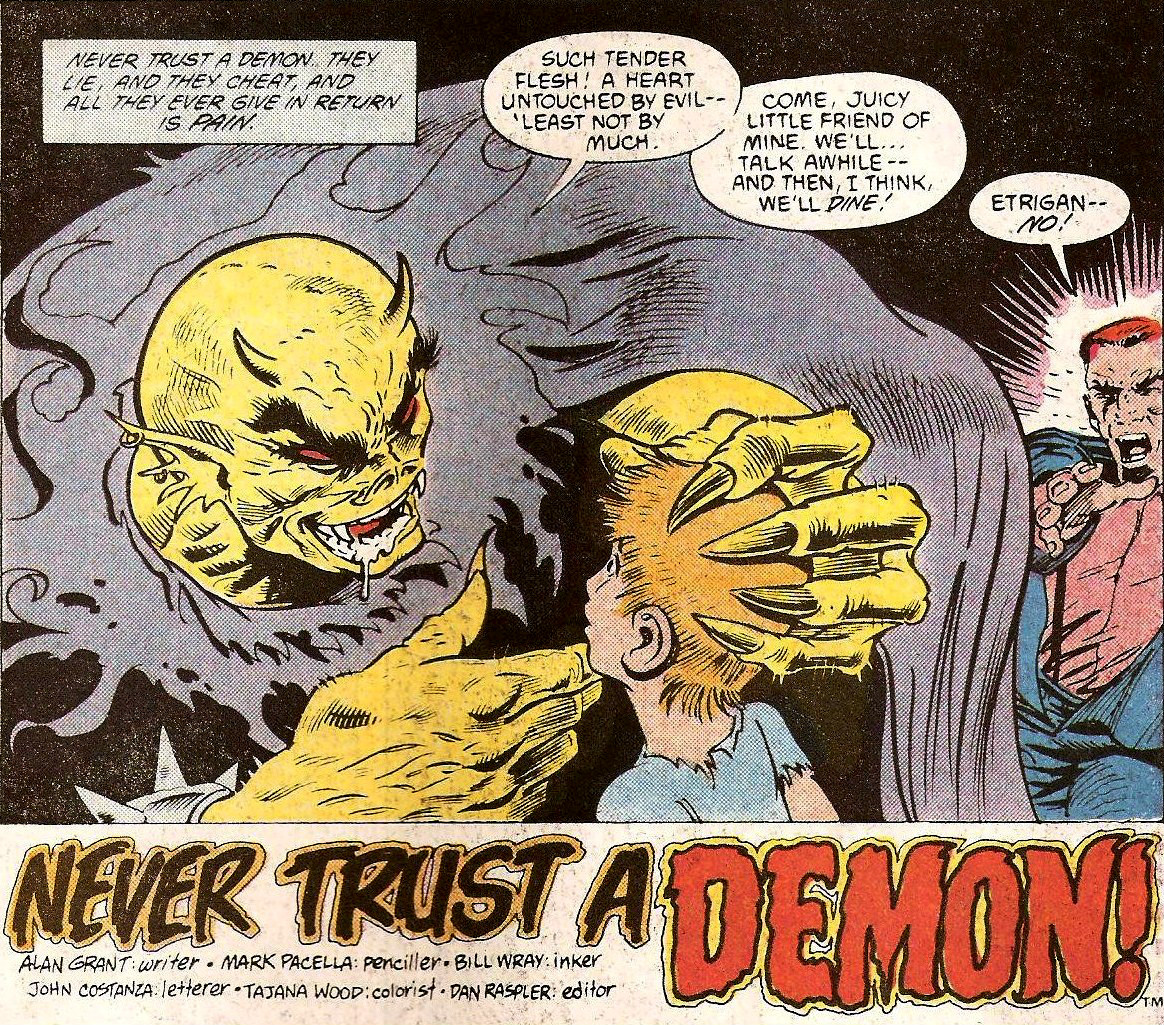
From Action Comics Weekly #637 (1989)
For the entirety of its publishing life, Action Comics Weekly was also the only place readers got Green Lantern stories. Hal Jordan‘s title, Green Lantern Corps, was cancelled just as the first Action Comics Weekly issue came out. His solo series had ended with nearly all of the Green Lantern rings around the universe being destroyed along with the Main Power Battery on Oa. Hal Jordan was almost entirely alone as one of the last Green Lanterns in the universe.
James Owsley, the writer later known as Christopher Priest, wrote Hal’s stories when ACW began. In the very first eight-page story in Action Comics Weekly #601, Carol Ferris was taken over by her Star Sapphire personality and immediately killed John Stewart’s ex-Green Lantern alien wife, Katma Tui.

From Action Comics Weekly #601 (1988)
It was a terrible plot point. There was absolutely no pay off for it aside from making John Stewart kinda grumpy. Katma was quickly forgotten after her death and barely rated a mention in later issues of this series. Her slaughter was useless and infuriating to readers who were fans of her. It didn’t help that Owsley abruptly left writing Hal’s stories at issue #608, right in the middle of a story.
Peter David took over Hal’s stories for a time. While David has written many wonderful comic stories in his long career, his run with Hal Jordan will never be remembered among them. During these stories, Hal fought some pretty lame villains and it was revealed that when the Green Lantern ring sought out Hal years earlier, it had partially lobotomized him in order to make him completely without fear, as Abin Sur’s instructions had specified.
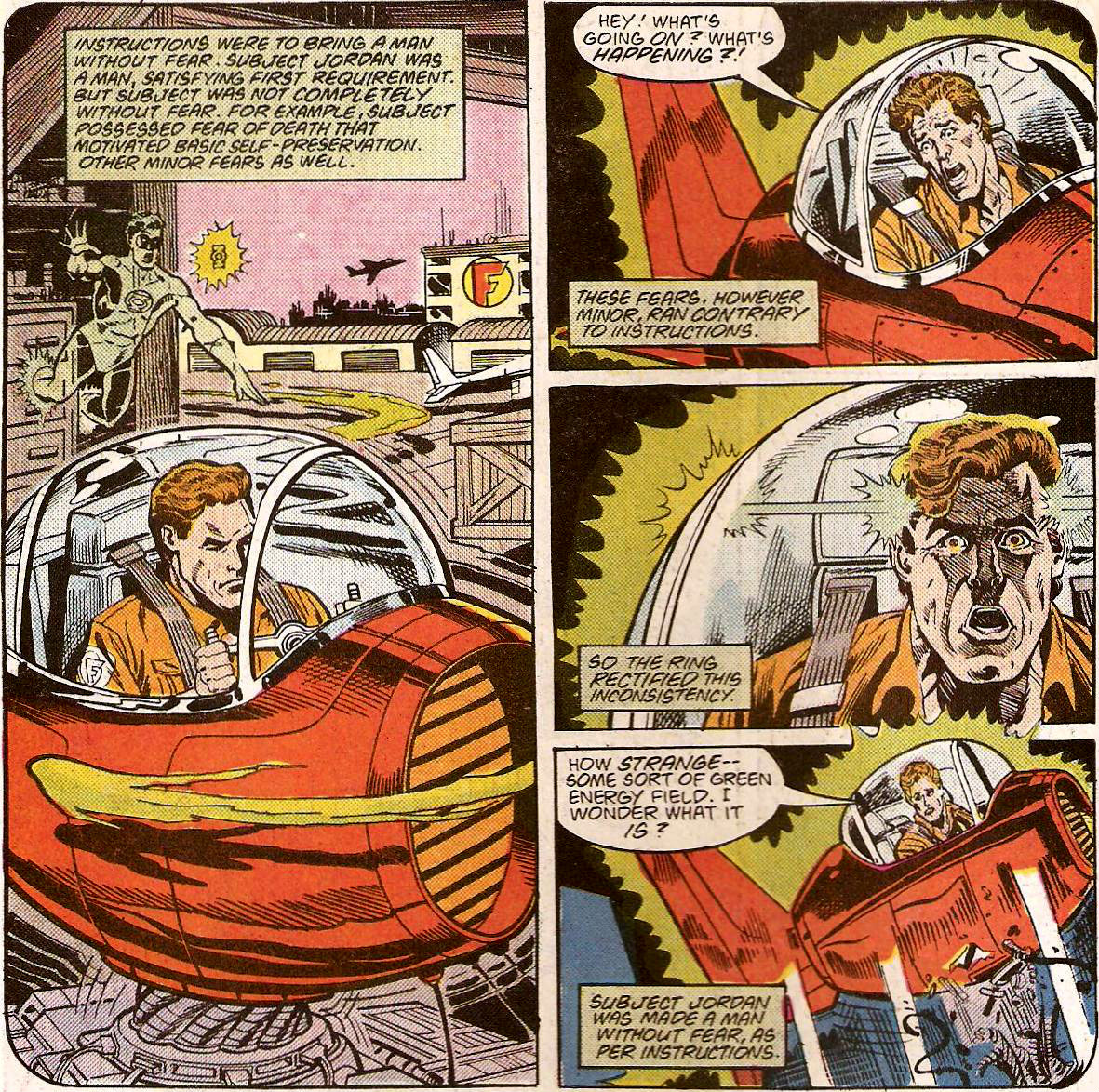
From Action Comics Weekly #614 (1988)
As with much of the rest of this run of Hal’s, the mind scrambling was never mentioned again.
The feature finally began to get good when James Owsley returned to it. This time, he brought along M. D. Bright, a favorite penciller of mine. Years later, he would go on to co-create Icon and, in 1997, Owsley (then Priest) and Bright created Quantum and Woody together. In any case, the duo brought a renewed quality to the feature that had been lacking in previous weeks. However, the story ended on an odd note.
Hal’s ring was completely destroyed while on an adventure. In a battle with a rogue Green Lantern, Hal simply took this alien Green Lantern ring as his own. Off he flew back to Earth, never realizing that this is what his opponent claimed he wanted to have happen.
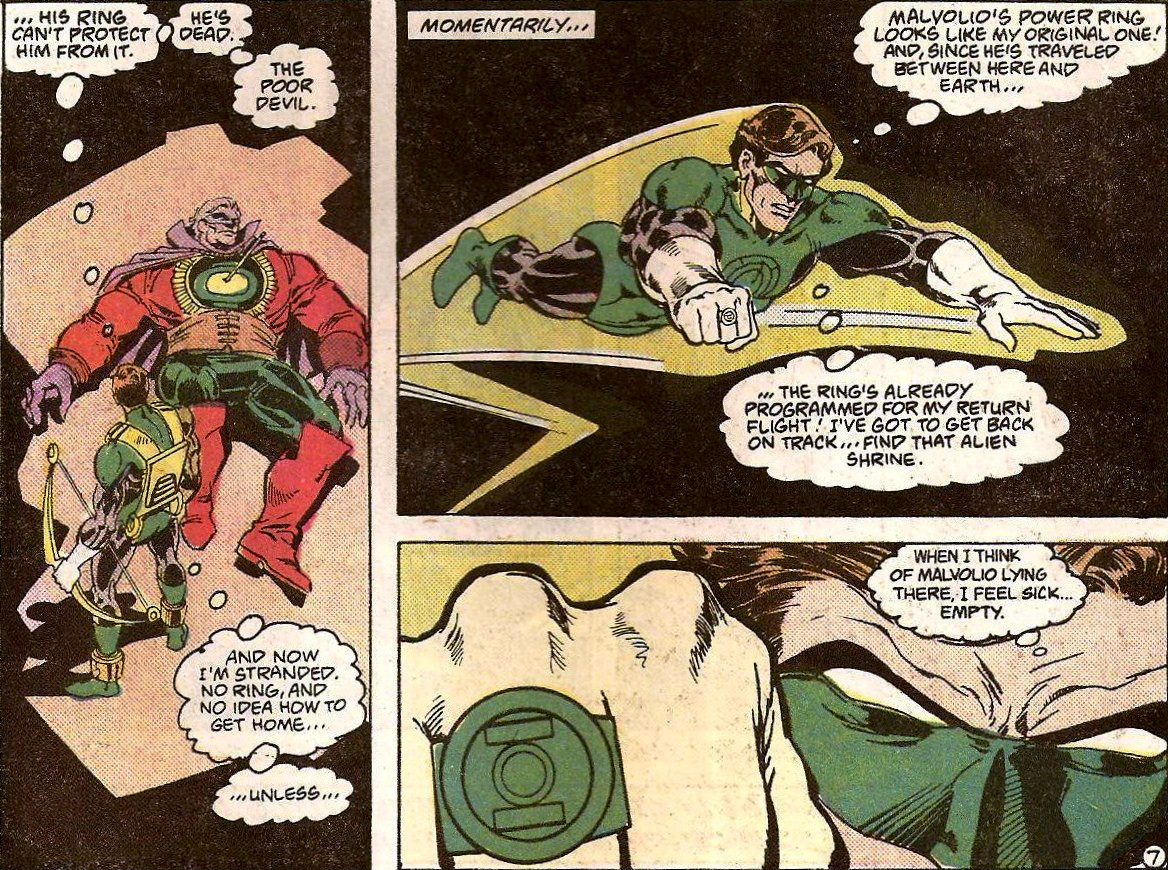
From Action Comics Weekly #635 (1989)
Malvolio was never mentioned again, though fans would later cite him as the reason Hal went insane years later when he re-destroyed the Green Lantern Corps. Perhaps it was Malvolio’s ring that changed Hal into Parallax? DC’s editors rejected that idea because that would mean they’d have to cite Action Comics Weekly and no one in DC editorial wanted to do that.
As much of a mess as some of the stories were, it was behind the scenes of Action Comics Weekly where things were really falling apart. Producing 48 pages every week was a huge load to bear for DC’s editorial team. Years later, Mark Waid, who was an editor at DC when ACW was in production, claimed that thoughts of getting the book out every week still wake him up screaming at night. An urban legend surfaced that Waid and Dan Raspler personally colored the Green Lantern story in issue #635 during one particularly awful Friday. Waid recently confirmed that story on Twitter.
.@IAmJustJoshing That IS correct. Raspler & I recolred the entire story over lunch b/c fill-in colorist messed up. Took joint pseudonym.
— Mark Waid (@MarkWaid) July 16, 2013
In the book’s letter columns, it was claimed that ACW was in the top third of DC’s comic sales. However, the whole thing just become too much of a headache for editorial to deal with. So, the series was cancelled. It was decided that with issue #643, Action Comics Weekly would revert to a Superman-only Action Comics and that George Perez would be the book’s sole writer and penciller. But, before this could happen, ACW gave editorial one more epic migraine.
Up and coming writer Neil Gaiman was asked to write Action Comics Weekly #642, which was to be a crossover between most of ACW‘s cast. He wrote, it got approved, and then it got quickly unapproved. One of the linchpins to Gaiman’s script was that Clark Kent and Hal Jordan were friends and knew each other’s secret identity. Mike Carlin, Superman’s group editor, balked at the idea and nixed the script. Clark Kent being Superman was one of the big secrets of the post-Crisis world. Not just anybody knew about it. Gaiman choose not to rewrite his story. In that script’s stead, an Elliot S. Maggin written tale was quickly commissioned. Its slapdash creation is evident and is a resounding thud of an ending to a title that began with such promise. Maggin, it should be said, probably had very little time to write his script so he really can’t be blamed.
Years later, it was realized that there was an unproduced Neil Gaiman script floating around in the ether. After tracking down a copy of it, it was finally published in 2000 as a one-off special titled Green Lantern / Superman: Legend of the Green Flame. The special is only fully comprehensible for people intimately familiar with DC continuity as it existed in 1989. It’s a strange throwback to a forgotten era. An era in which, it should be noted, the Phantom Stranger had an apartment in New York.
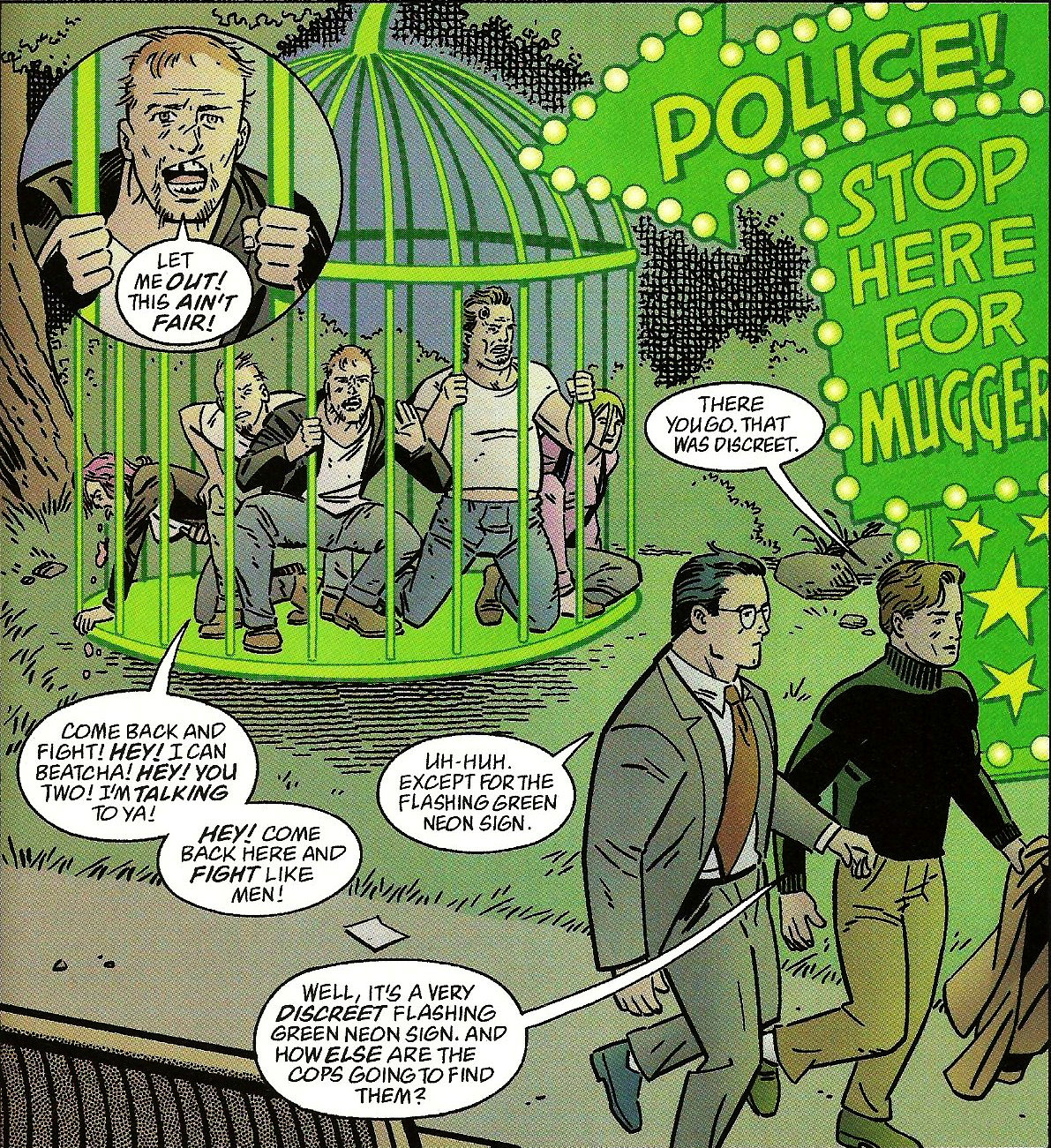
From Green Lantern / Superman: Legend of the Green Flame (2000)
Having said all of that, the initial idea of Action Comics Weekly is a great one. Anthology comics can be wonderful comics. If you don’t like one story, there are several more that may be more to your liking. That makes sense. It was simply the length and frequency that ACW was released at that killed it. A handful of readers complained that they were spending six whole dollars on the book every month, though that seems laughable to those of us in 2013. The title sold decently but couldn’t keep up the pace. These days, the only anthologies DC is publishing are collections of Digital First stories featuring Superman and Batman. A return of the true anthology is something I would champion. Here’s hoping that an editor takes a chance on it one day.
Jeff Reid wants Rick Burchett’s Blackhawks work to be collected eventually. Help him call for such a collection on Twitter.


An education as always, Jeff. All I knew about ACW was that it existed. It’s really interesting to read about all the ups and downs, pros and cons of the entire concept.
But do you really think such a thing would be possible now? I can’t see any publisher keeping up with that schedule and maintaining a standard of quality. Particularly given the state of DC editorial at the moment.
DC ran 52, and “Brightest Day” after that. BD was pretty terrible I thought, so maybe something like Spider-Man:BND where you have a group of writers that take turns with stories then switch?
Wonderful piece, Jeff. That offhand, brutal Katma Tui business soured me on Action Comics Weekly from the off, killing one character and tainting another for, as you say, no good reason.
@Wheelhands, yes, an ACW would be possible today, the anthology is the staple of the UK (and likely other) comic markets, it’s ‘just’ a matter of getting contributors who can manage the pace and form well enough so that the editor can get into the rhythm of the thing.
The anthology might be a staple in the UK but most tend to die on the vine in the US. Especially from Marvel and DC.
I mean, 52 worked but Countdown was a disaster. I’m sure it’d be possible, but I doubt it would last very long.
52 and Countdown weren’t anthologies. They were just weekly series. Wednesday Comics was both.
Good point. But I remain skeptical about something like Wednesday Comics having any kind of notable longevity, even as good as it was.
Well there’s Dark Horse Presents but that’s more like rolling out previews for ongoing than a series in its own right.
@Conor Absolutely, US readers aren’t ‘trained’ in the format – I was looking at the practicalities.
Great article, Jeff. As part of my larger GL run, I had to pick these issues up. While some distasteful stuff happens early on, the Christopher Priest GL story is actually pretty good, culminating in one of my favorite GL stories – Lord Malvolio! (The character has completely disappeared from use. Legend has it that DC and Christopher Priest were so at odds with each other after the end of ACW that when Gerard Jones asked to use Malvolio in a plot line years later, editorial told him no, they were not to acknowledge plot elements from Priest. Jones later snuck a fleeting reference to Malvolio in one issue, where Hal warns Guy Gardner about the encounter, but never uses his name.)
ACW is pretty hit or miss, story wise. I did rather enjoy the Black Canary and Nightwing and Speedy stories. Legend of the Green Flame is actually a pretty good story, if a little bogged down by being 11 years removed from its context.
The art turned me off to the Black Canary pieces and I felt the Nightwing and Speedy stories could have been better as well, especially the second one which claimed to be a Nightwing tale but didn’t feature Dick for over a month. Very annoying.
Legend of the Green Flame was good, especially when Mike Allred drew this section of it. But its climax rested on Alan Scott’s lantern, which was available due to his retirement and the fact that he was in Limbo when the story was originally written.
I didn’t talk about this in the article, but at several points in ACW‘s letter column, references were made to Marvel’s new anthology which launched in 1988, Marvel Comics Presents. DC made it sound like Marvel was cheating at the anthology format by having each issue be headlined by a member of the X-Men and by being bi-weekly, not weekly. It’s really impossible to fault Marvel for those decisions as MCP eventually ran for 175 issues and lasted all the way to 1995, a good six years more than ACW.
That’s where the Barry Windsor-Smith “Weapon X” story arc appeared. Marvel Comics Presents #72-84. Way back in 91. Good times.
What really killed ACW was the new Phantom Lee being rotten to a dog.
Awesome article. I bought this faithfully while in college and agree with most of your assessments. The Blackhawk run was a precursor to the great “Baxter” series also done by Pasko and Burchett. I enjoyed everything Peter David had written up to that point but Hal on the set of Oprah killed it for me. I remember WANTING to enjoy the Secret Six as we were promised the identity of Mockingbird after twenty-some years. But as you mentioned on multiple occasions, stories would lose their steam and ultimately this reader’s interests. Still, thanks for the trip down memory lane. Time to pull out the long boxes.
2000 AD and Weekly Shonen Jump, keeping the weekly Anthology alive. Someday US comics will find a way and the will to try again. You’d think Digital would make weekly anthologies lucrative again.
Even though each chapter of one usually runs $0.99?
It’s a shame anthologies don’t sell, but it makes sense. They only worked during the days when comics were a casual thing. These days it’s mostly just hobbyists and they tend to get hung up on things that “matter”. How often we forget that many of the characters we love today were created in one-shot stories.
I have an issue of this series at home, it starred the Phantom Stranger, Deadman, and GL (I didn’t much care for the other stories). I thought it was a great issue, the three stories I mentioned being priviotal to how I look at the characters now. Does anybody know when GL couldn’t just ‘ghost” thru walls anymore? I thought that was a sweet ability for him.
Maybe I’ll look for some backissues of this.
And also give some anthology issues a try. Adventures of Superman didn’t grab me the first time, but I”m jonesing for some good Supes right now (Batman/Superman was only an appirtizer).
If anyone could put something like this together again, Mark Chiarello would be the man.
DC Universe Presents was a nice idea but ultimately should’ve been a proper anthology – although when you look at the likes of Men of War, G.I. Combat, Sword & Sorcery and Threshold you can see why DC are put off by them.
I loved ACW and I loved this article… Thanks Jeff!!!
Anthology comics are the best, imo. Even if you didn’t like one story there was another AND you never know when you re-read it the lesser stories might’ve gotten better with age. My all time favorite was Shonen Jump. Now it’s the Batman Beyond Unlimited.